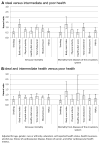Ideal cardiovascular health and mortality from all causes and diseases of the circulatory system among adults in the United States
- PMID: 22291126
- PMCID: PMC4556343
- DOI: 10.1161/CIRCULATIONAHA.111.049122
Ideal cardiovascular health and mortality from all causes and diseases of the circulatory system among adults in the United States
Abstract
Background: Recently, the American Heart Association developed a set of 7 ideal health metrics that will be used to measure progress toward their 2020 goals for cardiovascular health. The objective of the present study was to examine how well these metrics predicted mortality from all causes and diseases of the circulatory system in a national sample of adults in the United States.
Methods and results: We used data from 7622 adults ≥20 years of age who participated in the National Health and Nutrition Examination Survey from 1999 to 2002 and whose mortality through 2006 was determined via linkage to the National Death Index. For the dietary and glycemic metrics, we used alternative measures. During a median follow-up of 5.8 years, 532 deaths (186 deaths resulting from diseases of the circulatory system) occurred. About 1.5% of participants met none of the 7 ideal cardiovascular health metrics, and 1.1% of participants met all 7 metrics. The number of ideal metrics was significantly and inversely related to mortality from all causes and diseases of the circulatory system. Compared with participants who met none of the ideal metrics, those meeting ≥5 metrics had a reduction of 78% (adjusted hazard ratio, 0.22; 95% confidence interval, 0.10-0.50) in the risk for all-cause mortality and 88% (adjusted hazard ratio, 0.12; 95% confidence interval, 0.03-0.57) in the risk for mortality from diseases of the circulatory system.
Conclusion: The number of ideal cardiovascular health metrics is a strong predictor of mortality from all causes and diseases of the circulatory system.
Figures

Comment in
-
Empirical support for cardiovascular health: the case gets even stronger.Circulation. 2012 Feb 28;125(8):973-4. doi: 10.1161/CIRCULATIONAHA.111.088542. Epub 2012 Jan 30. Circulation. 2012. PMID: 22291125 No abstract available.
References
-
- Murphy SL, Xu J, Kochanek KD. [Accessed February 7, 2012];Deaths: Preliminary Data for 2010. http://www.cdc.gov/nchs/data/nvsr/nvsr60/nvsr60_04.pdf.
-
- Lloyd-Jones DM, Hong Y, Labarthe D, Mozaffarian D, Appel LJ, Van HL, Greenlund K, Daniels S, Nichol G, Tomaselli GF, Arnett DK, Fonarow GC, Ho PM, Lauer MS, Masoudi FA, Robertson RM, Roger V, Schwamm LH, Sorlie P, Yancy CW, Rosamond WD. Defining and setting national goals for cardiovascular health promotion and disease reduction: the American Heart Association’s Strategic Impact Goal through 2020 and beyond. Circulation. 2010;121:586–613. - PubMed
-
- Strasser T. Reflections on cardiovascular diseases. Interdisciplinary Sci Rev. 1978;3:225–230.
-
- Stamler J, Stamler R, Neaton JD, Wentworth D, Daviglus ML, Garside D, Dyer AR, Liu K, Greenland P. Low risk-factor profile and long-term cardiovascular and noncardiovascular mortality and life expectancy: findings for 5 large cohorts of young adult and middle-aged men and women. JAMA. 1999;282:2012–2018. - PubMed
-
- Stampfer MJ, Hu FB, Manson JE, Rimm EB, Willett WC. Primary prevention of coronary heart disease in women through diet and lifestyle. N Engl J Med. 2000;343:16–22. - PubMed
Publication types
MeSH terms
Grants and funding
LinkOut - more resources
Full Text Sources
Miscellaneous

